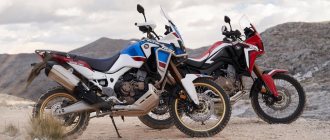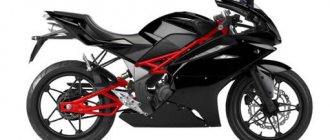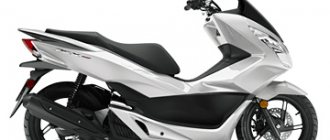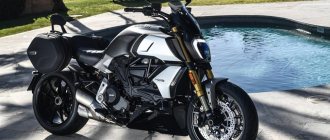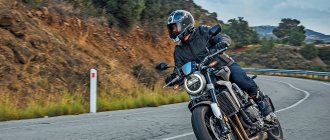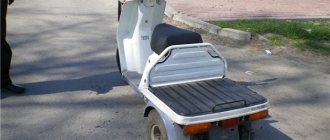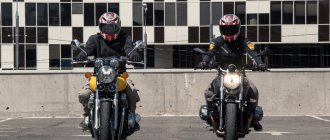| Honda CB1000R (2008-2017) | Honda CB1000R (2018+) | Honda CB1000R+ (2018-2020) |
Honda CB1000R naked model
was first presented in November 2007 at the Milan Bike Show as a replacement for the obsolete Honda CB900F Hornet model. The model was based on the engine from the sports version of the Honda CBR1000RR (2007), which was retuned and derated to increase traction at low and medium speeds. As a result, the engine began to produce about 125 hp. power and 99 Nm of torque, available at 7750 rpm. The styling of the bike shares visual cues with the 2007 Honda Hornet 600.
Comparing the Honda CB1000R with the Honda CBF 1000 model, which also used the engine from the liter Fireblade, it should be noted that on the Honda CB1000R it is more powerful, has 30% more power and a pronounced sporting character.
Another important point is that, despite the similarity of the names Honda CB1000R and Honda CB1000SF, these motorcycles have nothing in common with each other. The Honda CB1000 Super Four is a classic motorcycle produced by the company from 1992 to 1997 and is the predecessor to the Honda CB1300SF.
Key features of the Honda CB1000R include an aluminum frame, a cantilever rear swingarm, fully adjustable sports suspension, a 6-speed gearbox and powerful brakes with the available option of installing a combined ABS system.
In 2022, the Honda CB1000R model underwent a major restyling, receiving a new appearance, a retuned engine (maximum power increased to 145 hp), electronic throttle, ABS as standard (2-channel, without combination brake), traction control system ( Honda Selectable Torque Control) with three operating modes (controls parameters such as engine power, engine braking, torque transmission to the rear wheel) and a wider rear wheel (by 190 mm).
Honda CB1000R (2018+): electronic assistants
- ABS
- Ride-by-Wire system (electronic throttle)
- Honda Selectable Torque Control - traction control system
- Riding Modes - selecting the engine operating mode
- Assist/Slipper Clutch - assistant and slipper clutch system
- Engine Brake - engine braking control system
- Heated steering grips – Honda CB1000R+
- Quickshifter - quickshifting system (shifting gears without clutch) - Honda CB1000R+
Honda CB1000R+ equipment:
- Single saddle
- Aluminum body parts (fenders, dashboard, seat cover)
- Radiator grille with CB1000R logo
- Heated steering grips
- Quickshifter
The main competitors of the Honda CB1000R in the class:
- Kawasaki Z1000 / Kawasaki Z900
- Suzuki GSF 1250 N Bandit / Suzuki GSX-S1000
- Yamaha FZ-1/Yamaha MT-10
Brief history of the model
- 2008 - start of production and sales. First generation
.
Model:
Honda CB1000R (Europe, Oceania).
Model code
: CB1000R8.
- 2009 - no significant changes.
Model:
Honda CB1000R / CB1000R (ABS) (Europe, Oceania).
Frame number:
ZDC
SC60A
XXXXXXXXXXX, ZDC
SC60C
XXXXXXXXXXX - UK, Europe;
ZDC SC60B
XXXXXXXXXXX, ZDC
SC60D
XXXXXXXXXXX - France;
ZDC SC60U
XXXXXXXXXXX - Oceania.
Model code:
CB1000RA / CB1000RAA.
- 2010 - no significant changes.
Model:
Honda CB1000R + ABS (Europe, Oceania).
Frame number:
ZDC
SC601B
XXXXXXXXXX.
Model code:
CB1000RA / CB1000RAA.
- 2011 - no significant changes.
Model:
Honda CB1000R + ABS (North America, Europe).
Frame number:
ZDC
SC601C
XXXXXXXXXX.
Model code:
CB1000RB + CB1000RAB.
- 2012 - no significant changes.
Model:
Honda CB1000R + ABS (North America, Europe).
Frame number:
ZDC
SC601D
XXXXXXXXXX.
Model code:
CB1000RC + CB1000RAC.
- 2013 - no significant changes.
Model:
Honda CB1000R + ABS (North America, Europe).
Frame number:
ZDC
SC605E
XXXXXXXXXX, ZDC
SC601E
XXXXXXXXXX.
Model code:
CB1000RD + CB1000RAD.
- 2014 - no significant changes.
Model:
Honda CB1000R + ABS (North America, Europe).
Model code:
CB1000RE + CB1000RAE.
- 2015 - no significant changes.
Model:
Honda CB1000R + ABS (North America, Europe).
Model code:
CB1000RF + CB1000RAF.
- 2016 - no significant changes.
Model:
Honda CB1000R + ABS (North America, Europe).
Model code:
CB1000RF + CB1000RAF; CB1000RG.
- 2017 - no significant changes.
Model:
Honda CB1000R ABS (Europe).
Model code:
CB1000RAF.
- 2018 - restyling of the model. Second generation
. The model receives a new appearance, a redesigned engine (increased compression ratio, maximum power increases to 145 hp), traction control system with three operating modes, electronic throttle, slipper clutch with an assistant, ABS in the basic version (without combination brakes) , reduced fuel tank (from 17 to 16.2 l), cable-operated clutch (instead of hydraulics) and lower curb weight (212 kg).
Model:
Honda CB1000R ABS (Europe, North America, Oceania).
Model code:
CB1000RAJ.
- 2019 - no significant changes.
Model:
Honda CB1000R ABS (Europe, North America, Oceania).
Model code:
CB1000RAK.
- 2020 - no significant changes.
Model:
Honda CB1000R ABS (Europe, North America, Oceania).
Model code:
CB1000RAL.
- 2021 - no significant changes.
Model:
Honda CB1000R ABS (Europe, North America, Oceania).
Model code:
CB1000RAM.
- 2022 - no significant changes.
Model:
Honda CB1000R ABS (Europe, North America, Oceania).
Model code:
CB1000RAN.
Honda CB1000R: Model concept
The new CB1000R combines the best qualities of a liter Super Sports motorcycle in a compact, rugged and powerful design that evokes good times and friends racing along the avenues, among the bright lights of the city, in search of new thrills. Sales of larger-displacement Naked motorcycles have increased significantly in recent years, appealing to both experienced and novice riders for their laid-back style and sheer riding pleasure. These riders are looking not only for thrilling performance, but also for design that enhances their sense of pride in the motorcycle they ride. Introduced in 2002, the Honda Hornet 900 starred in the Performance Naked liter class, featuring Hornet styling, compliant, responsive handling and strong mid-range acceleration from the retuned Honda CBR900RR Fireblade . However, the Honda Hornet 900 is behind the times because... Pollution standards had changed and it was necessary to start with a clean slate by designing the new flagship of the Performance Naked range.
Honda 's team of development engineers set out to create a bold new design concept, the Performance Naked, incorporating the latest innovations developed for the powerful, top-of-the-line Super Sport sports machines. Focusing on looks, power and handling, and emphasizing optimized proportions and lightweight design, the team has delivered an all-new concept with an aggressive street bike design that sets the mood for racing. Whether cruising the streets or even standing still, the exciting new look of the Honda CB1000R is sure to create a chapter in the history of Performance Naked motorcycle design.
Aiming to create a motorcycle that would be as enjoyable and exhilarating as it is elusive when riding around town, the engineering team used newly developed and proven engine and chassis components that together can deliver the desired level of power in a compact configuration, allowing more people to enjoy these achievements of Honda.
The development team gradually began to concentrate on the leading theme - creating an image of a motorcycle for commuting in the city. The kind with which you would like to join your friends, a motorcycle that would attract admiring glances with its unforgettable design, excellent quality and execution of details. And then, with the roar of the engine and the squeal of tires, he took off, confirming his power and impressive appearance: “King of the Parties.”
Honda CB1000R design team began creating a compact, super-handling mid-size steed that delivers amazing acceleration and response to every turn of the throttle. Which provides smooth and easy control even in heavy traffic, but at any moment can live up to its image of a wild cat, quickly taking off. A bike that's easy to handle on twisty roads and that everyone will want to ride again and again.
Design Features
- A stylish, sophisticated look with an exciting Performance Naked design.
- The forward design, which places the driver closer to the front of the car, is emphasized by a short and compact fairing.
- Eye-catching high-tech details, along with a sophisticated overall design, attract increased attention.
- An angular, semi-hidden exhaust system that lowers the bike's center of gravity for easy handling.
- New triangular headlights with multi-layer reflectors and a unique LED arrangement integrated into the compact fairing.
- Attractive 17″ wheels with distinctive four-spoke design.
- Magnesium cylinder head and alternator caps to reduce engine weight.
Performance characteristics
- Compact, lightweight, 998cc, liquid-cooled, 4-cylinder engine is based on the CBR1000RR Fireblade.
- High-pressure die-cast aluminum Mono-Backbone frame.
- Fast steering, fully adjustable 43mm inverted front fork.
- Lightweight and rigid cast aluminum Pro-Arm swingarm supported by adjustable Monoshock rear suspension.
- Wide Super Sports radial tires.
- Lightweight floating front disc brakes with 310mm four-cylinder radial-mount calipers. Rear disc brakes 256 mm with two-cylinder caliper.
- Integral ABS includes a three-cylinder caliper and an advanced anti-lock system for confident braking control in all situations.
Styling / The Honda CB1000R is unflappable but can take off from a standstill, its lightweight lines showcasing a thoroughly reworked core design, while the voluminous mechanical details create a breathtaking effect. The stylish exterior of the Honda CB1000R embodies the design concept of an aggressive motorcycle with uncompromising lines, reflecting the appearance of a big jungle cat, poised and ready to surprise its prey. Much of this aggressive look comes from the distinctive forward-moving styling, which places the driver slightly ahead and visually above the dynamic four-cylinder inline engine. The short, narrow fairing, voluminous forward-sloping fuel tank and side fairings more accurately convey the image of the partygoer - the "King of the Party". Mechanical details give the car a high-tech look with an emphasis on power, highlighted by an abundance of eye-catching nickel-plated bolts.
The appearance of the new shorter and narrower Honda CB1000R and rear fairing is noticeably influenced by the redesigned Honda CBR1000RR Fireblade Honda's powerful RC212V race bike . Thanks to its compact shape, the driver is even closer to the steering wheel. When riding, the Honda CB1000R's is slightly forward towards the front wheel, which adds confidence when handling the twisty roads that sportbike riders love.
the Honda CB1000R's compact fairing is flanked by a shiny new triangular-shaped headlamp with multi-layer reflectors and a unique LED bulb arrangement. Behind the fairing is an eye-catching, high-tech, fully digital instrument panel with three large displays that display all operational parameters. The tachometer is a responsive, multi-segment LED display that shows engine speed on a wide, easy-to-read panel that runs across the motorcycle's solid top. Below, a large, high-performance reverse front fork complements a durable, upgraded Pro-Arm swingarm, while both sleek 17″ four-spoke wheels put a strong emphasis on the Honda CB1000R's . The next thing that impresses about the stunning looks of the Honda CB1000R is its size. Surprisingly, the Honda CB1000R looks and feels more like a mid-sized compact sports bike than a full-fledged 1000cc motorcycle.
Engine/ Honda's new 998cc, liquid-cooled, fuel-injected CB1000R four-cylinder engine delivers the breathtaking power and superior performance you'd expect from a liter-powered street bike.
It inherited its jet power from the direct descendant of the Super Sport class winning motorcycle, the Honda CBR1000RR Fireblade . Like the Hornet, the Honda CB1000R's has been optimized to deliver more low-to-mid-range power, creating quicker acceleration at lower rpms and more torque creating propulsion with every twist of the throttle. However, unlike the Honda CBF1000 , the new engine of the Honda CB1000R has more power that goes beyond the norm.
Add to that the Honda CB1000R's than other motorcycles, and you get amazing power. Power and torque build smoothly and effortlessly from a standing start, propelling you towards the horizon.
All power is sent to the rear wheel via an easy-to-operate hydraulic clutch that takes full advantage of the high torque at low rpm, allowing clutch retention at engine speeds below 2,000 rpm. without the risk of stalling. Even the transmission has been modified to deliver remarkably smooth operation, with first gear shifting into gear with a slight click instead of a thud.
Maximum Torque/ For many people, the concept of "torque" versus "power" is a difficult one to conceptualize, especially the seemingly contradictory idea that torque can be increased by decreasing maximum power. Maximum power, unsurprisingly, seems to be the main goal of motorcycle engine design, with more power being considered better performance and therefore more fun. However, this is not always the case, especially for multi-cylinder engines, which tend to produce maximum power at higher RPMs than single or twin cylinder engines.
It's the torque, not the peak power, especially in the midrange, that really creates the "power" that's felt when you hit the throttle. That powerful jolt of acceleration that pushes you into the back of your seat is a sign of powerful torque producing maximum acceleration, not just big numbers in maximum power output. In racing, torque is what accelerates a bike out of a corner or up a hill. On the streets, that same torque gives you the most exhilarating feeling of boundless energy and acceleration. And the faster it works, the greater the excitement and pleasure of pressing the gas.
There is a zone within the engine's powerband that many riders use most of the time, as it is the most efficient at making the bike feel playful. Peak power is good for racers and those who live on the edge, but it's the torque that you really feel and depend on for that thrilling rush of acceleration that will quickly propel you down the road away from the city lights. And it is torque that the new Honda CB1000R to maximize it when tuning the engine.
The result is superior acceleration across the entire power band. With the new Honda CB1000R, just step on the gas and go, no need to wait. In fact, thanks to its light weight and thus increased power-to-weight ratio, the new Honda CB1000R delivers better acceleration dynamics across the entire power band than any other motorcycle in its class, and indeed than some significantly superior motorcycles. engine volume. You don’t have to take his word for it, see for yourself - sit on it, open the gas!
Exhaust System/ As with the 2007 Hornet, one of the main design goals of the new Honda CB1000R was to achieve optimal mass centralization for faster, more neutral handling. One of the factors that contributes to the motorcycle's weight distribution is the exhaust system, much like the 2007 Hornet and 2008 Honda CBR1000RR Fireblade Honda CB1000R features a low-mounted exhaust system with most of its weight concentrated directly underneath. engine. This results in a much quicker response to steering input, which is especially noticeable when leaning into tight corners or weaving through the test.
The exhaust pipes run vertically down from the engine exhaust ports and join near the front lower edge of the engine, where the two exhaust pipes connect to the large primary muffler and catalytic converter system located under the engine and rear of the main frame. The exhaust then passes through a sleek, upward-facing extension housing the main muffler and exits through a unique, stylish exhaust pipe.
The Honda CB1000R's exhaust system also took special care to maximize cornering clearance, with the angular shape of this stainless steel structure specifically designed to prevent contact with the ground when leaning hard to the right. The bike's single-sided Pro-Arm swingarm also contributes by further increasing clearance.
The system's integrated oxygen sensor and catalyst combine with an advanced fuel injection system to provide low emissions compliant with current EURO-3 standards, while maintaining smooth, high performance across the engine's wide power band.
Chassis/ To achieve a more compact mid-engined motorcycle shape for improved overall performance, the new Honda CB1000R is built on the rigid Mono-Backbone frame first introduced on the 2007 Hornet.
The innovative high-pressure extruded aluminum frame is a fairly simple design, yet provides optimal strength by holding the engine, a stress-prone element, in a rigid, diamond-shaped structure. Three hollow cast frame sections (front tube, main support and pivot joint) are welded into a small structure that wraps around the engine and is lighter than traditional steel tube construction, providing exceptional strength and rigidity for more responsive yet smooth handling and instant response. to change the direction of movement.
Weight Shift Design To achieve the best handling required in this new liter-class machine, the Honda CB1000R has been designed to be one of the lightest, most compact and balanced street motorcycles in its class, with a silhouette and proportions more familiar to mid-displacement sportsbikes. engine. The usual emphasis on an optimal center of gravity on most modern Honda performance motorcycles is responsible for the excellent ride quality of the new Honda CB1000R . Its heavier parts, namely the engine, main frame sections and exhaust system, were positioned as close to its center of gravity as possible, while the sections further out from the center were made as light as possible.
Full Sportbike Suspension/ Like its more powerful sibling, the Honda CBR1000RR Fireblade , the Honda CB1000R rides on a durable and responsive HMAS cartridge-type front fork at the front, which provides excellent handling on tight corners and over bumps for more confident control that rivals quality with many more comfort-oriented motorcycles. In addition to providing a smooth ride, the fork also fully adjusts preload, compression and rebound, allowing ride quality to be customized to the rider's preference.
At the rear, an adjustable Monoshock shock sits between the single-sided cast-aluminum Pro-arm swingarm and the rear of the frame to provide 128mm of smooth travel—a secure ride with matching comfort.
High-Performance Brakes and Wheels/ Like the best Honda Super Sport racing motorcycles, the new Honda CB1000R 's four-spoke cast aluminum wheels carry Z-grade Super Sport tires, including an impressively wide 180/55 17″ radial rear tire. With a special appearance, these tires guarantee precise and responsive cornering control when driving on the streets at high speeds. The Honda CB1000R's four-bolt rear wheel is held in place to further enhance its stylish city-dweller appearance, sitting under a short, raised rear fairing.
Fast motorcycles need strong brakes, and in its basic configuration, the new Honda CB1000R features a pair of impressive radial-mount four-cylinder front calipers, like those found on the race-winning CBR motorcycles. These lightweight yet powerful calipers wrap around 310mm floating discs for braking performance on par with the fastest Super Sport motorcycles. At the rear, an eye-catching Pro-Arm swingarm is fitted with a compact twin-cylinder caliper and a 256mm braking disc for better balance and smooth, responsive braking control.
Integral ABS Version/ The new Honda CB1000R also comes with ABS, which features reliable braking control through Honda's , coupled with its smooth, confidence-inspiring Anti-Lock Braking System. Externally, the only difference between the standard version and the version with ABS are the front calipers.
Replacing the standard version's four-cylinder radially mounted high-performance calipers is a combination of three-cylinder calipers wrapping the same 310mm floating disc. A small impulse disc is also installed on both wheels, which is constantly monitored by the anti-lock brake system.
Equipment/ Like most larger displacement Honda Honda CB1000R is also equipped with the Honda (HISS).
The Honda Ignition Security System (HISS) uses a secure electronic lock to prevent the engine from starting without the use of two original keys, providing an effective anti-theft deterrent. Designed to completely de-energize the engine at the most critical point in the ignition system, the HISS system cannot be fooled by shorting the ignition or replacing the ignition switch module.
Accessories/ Honda will supply the new Honda CB1000R with a range of accessories and accessories to enhance its energetic, eye-catching styling and enhance its performance versatility.
Accessories include:
- The rear fairing guards are color-matched to complement the CB1000R's aggressive appearance.
- Luxuriously finished Alcantara seat.
- A set of lightweight and stylish carbon fiber parts designed for the new CB1000R.
- Set of decorative panels.
- Compact anti-theft module with motion sensor, siren and auxiliary battery to provide additional protection against vandals and theft. Low power sleep mode protects the battery from draining.
Go to Honda CB1000R
Check out the test drives:
- Test drive of the Honda CB1000R motorcycle
- Honda CB1000R: Test drive from Za Rulem magazine
Recall of the Honda CB1000R motorcycle
- Read review of Honda CB1000R
Specifications
Technical characteristics of Honda CB1000R:
| Model | Honda CB1000R |
| Motorcycle type | naked |
| Year of issue | 2008+ |
| Frame | aluminum |
| engine's type | 4-cylinder, 4-stroke, in-line |
| Working volume | 998 cm³ |
| Bore/Stroke | 75 mm x 56.5 mm |
| Compression ratio | 11.2:1 - CB1000R (2008-2017) 11.6:1 - CB1000R (2018+) |
| Cooling | Liquid |
| Number of valves per cylinder | DOHC, 4 valves per cylinder |
| Fuel supply system | electronic injection PGM-FI, 39 mm + electronic throttle (Throttle By Wire) - CB1000R (2018+) |
| Ignition type | transistor |
| Maximum power | 125 hp (92 kW) at 10000 rpm - CB1000R (2008-2017) 109.44 hp (81.61 kW) - on wheel - CB1000R (2008-2017) 145.5 hp (107 kW) at 10500 rpm - CB1000R (2018+) + Traction control (Honda Selectable Torque Control) - CB1000R (2018+) |
| Maximum torque | 99 Nm (10.1 kg*m) at 7750 rpm - CB1000R (2008-2017) 87.4 Nm (8.8 kg*m) - at wheel - CB1000R (2008-2017) 104 Nm (10.5 kg*m) at 8250 rpm - CB1000R (2018+) |
| Clutch | Multi-disc in oil bath, hydraulic drive (until 2018) + Assist & Slipper clutch — CB1000R (2018+) Cable drive - CB1000R (2018+) |
| Transmission | 6-speed |
| type of drive | chain |
| Front tire size | 120/70 ZR17 |
| Rear tire size | 180/55 ZR17 - CB1000R (2008-2017) 190/55 ZR17 - CB1000R (2018+) |
| Front brakes | 2 discs, 310 mm, 4-piston radial calipers – CB1000R, CB1000R ABS (2018+) 2 discs, 310 mm, 3-piston calipers (combined) – CB1000R ABS (2008-2017) |
| Rear brakes | 1 disc 256 mm, 2-piston caliper (ABS) |
| Front suspension | 43 mm HMAS inverted fork (all adjustments), travel - 120 mm |
| Rear suspension | cantilever pendulum with HMAS monoshock absorber (all adjustments), stroke - 128 mm |
| Length | 2105 mm - CB1000R (2008-2017) 2120 mm - CB1000R (2018+) |
| Width | 785 mm - CB1000R (2008-2017) 789 mm - CB1000R (2018+) |
| Height | 1095 mm |
| Wheelbase | 1445 mm - CB1000R (2008-2017) 1455 mm - CB1000R (2018+) |
| Seat height | 825 mm - CB1000R (2008-2017) 830 mm - CB1000R (2018+) |
| Minimum ground clearance (clearance) | 130 mm - CB1000R (2008-2017) 135 mm - CB1000R (2018+) |
| Acceleration 0-100 km/h (0-60 mph) | 3.15 sec[1] |
| Maximum speed | 228 km/h[2] |
| Gas tank capacity | 17.0 l (including reserve - 4.0 l) - CB1000R (2008-2017) 16.2 l - CB1000R (2018+) |
| Motorcycle weight (curb) | 217 kg – CB1000R (2008-2017) 222 kg – CB1000R ABS (2008-2017) 212 kg – CB1000R ABS (2018+) |
Chassis and brakes
The frame of this machine is made of aluminum, which is not surprising considering how it positions itself. Of course, the wheels here are alloy, and by the way, they look very stylish. The steering wheel has standard dimensions for the class and is unremarkable.
The rear suspension is a cantilever pendulum version with a monoshock absorber. At the front it is an inverted fork with dimensions of 43 mm. For such a motorcycle this option is quite acceptable. Braking at the rear is a 256mm disc along with a two-piston caliper, while at the front there are a pair of 310mm discs with four-piston calipers.
Reviews
Reviews of Honda CB1000R:
Expand Collapse
Great bike for the city! Beautiful unusual Italian design, monopendulum! Good! we can say excellent acceleration dynamics, I would like the brakes to be better; for a weight over 210, it seems to me that it stops slowly. The donor for it was the CBR 1000RR until 2007, before that I rode sports, in city mode it is extremely inconvenient!
The CB 1000R has excellent handling, a comfortable seating position, long gears, a shorter drive and a rest, a derated engine (123 hp) will not give any offense to sports. The most comfortable maximum speed is 220 km/h, maybe 240, but just hang in there)))))
Now for the consumables! I have driven 7000 km for a season and a half, changed the oil twice, brake fluid, rear air cylinder, front pads. It’s better to take EVERYTHING original, it’s a little expensive, but it’ll give you peace of mind! I only use 98 Benz. HONDA 10w30 oil.
I have a CB1000 RA. I skated the season almost every day, mostly in good weather, although I was in the rain a few times. What can I say? Before that I had a Yamaha Thunderrace 1000. I was disappointed in all aspects, so I chose only a Honda, mainly for the city and traffic jams, with short trips somewhere and specifically with ABC. I’ll say right away that the motorcycle did not disappoint. Confident traction from the very bottom with pick-up at 6500. It quickly picks up speed with the lifting of the front end, but everything is very controlled. Turning the speedometer over 200 km/h is no problem. But somewhere around 230 you need to lie down on the tank. Extremely friendly to the pilot, forgives many mistakes. One combined braking system with ABC is worth it: in any weather, on any surface, with any force on any brake. It's a pleasure to pierce plugs on it, despite its 225 kg curb weight. It steers very easily and takes turns in such a way that the comrades driving behind are surprised. Although I noticed this nuance: with a passenger weighing up to 50 kg, turning turns is much easier and more interesting. In short, I have never regretted the purchase. Among the additional features, I installed an alarm system, a GIVI windshield, xenon, a case with a GIVI mount, and, of course, sliders. For more than seven thousand I did two maintenance (break-in and mileage); The rear balloon can be thrown out in the spring (the VT-015 is a bit weak for it). The rest is just a thrill.
I became the proud owner of a cb1000ra 2012. Before that I drove a fz6s 2006. I’ll make a reservation that I haven’t driven a phaser-liter, but I’ve read about it. I'm still shocked by my Honda. And this takes into account the uncompleted run-in and the nauseating mode. The way it steers is incredibly delightful. For the city, I think, the most ideal bike. The box is singing! Everything is clear and harmonious. even at the bottom, without crossing the 5 thousand rpm mark, it has excellent dynamics! Very smooth motor. No pokes when closing the throttle. In short, I would marry her. If you go long-distance, then a phaser is of course better, but otherwise... I'm now a devoted fan of the cb1000r!
Ps: the lack of wind protection is ultimately a plus, because Necker can drive 200 in the city :acute: . I sinned myself, but now I’m glad that it won’t be comfortable to shoot like that)
Bike features
Here are the advantages of the Honda SB 1000 R:
- high dynamic performance for the class on a good road;
- good motorcycle handling even at high speeds;
- The seat is comfortable for the back, which allows you to ride for a long time in comfort.
The bike is a fairly powerful model, which is in no way suitable for an inexperienced driver. It is too aggressive in its speed parameters, despite the fact that the torque is smoothed out and the car does not jerk when accelerating.
